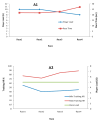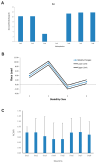Wearable System Applications in Performance Analysis of RaceRunning Athletes with Disabilities
- PMID: 39771661
- PMCID: PMC11679408
- DOI: 10.3390/s24247923
Wearable System Applications in Performance Analysis of RaceRunning Athletes with Disabilities
Abstract
RaceRunning is a sport for disabled people and successful performance depends on reducing the amount of time spent travelling a specific distance. Performance analysis in RaceRunning athletes is based on traditional methods such as recording race time, distances travelled and frequency (sets and reps) that are not sufficient for monitoring training loads. The aims of this study were to monitor training loads in typical training sessions and evaluate technical adaptations in RaceRunning performance by acquiring sensor metrics. Five elite and competitive RaceRunning athletes (18.2 ± 2.3 yrs) at RR2 and RR3 levels were monitored for 8 weeks, performing in their usual training sessions while wearing unobtrusive motion sensors. The motion sensors were attached to the waist and lower leg in all training sessions, each lasting between 80 and 90 min. Performance metrics data collected from the motion sensors included player loads, race loads, work/rest ratio and impact shock directions, along with training factors (duration, frequency, distance, race time and rest time). Results showed that weekly training loads (player and race loads) followed acceptable threshold levels, according to assessment criteria (smallest worthwhile change, acute/chronic work ratio). The relationship between race velocity (performance index) and race load was non-linear and statistically significant, which led to different performance efficiency groups. Wearable motion sensor metrics revealed small to moderate technical adaptations following repeated sprint attempts in temporal running performance, variability and consistency. In conclusion, using a wearable-based system is an effective feedback tool to monitor training quality, revealing important insights into adaptations to training volumes in disabled athletes.
Keywords: RaceRunning; adaptations; feedback; performance efficiency; training loads; wearable-motion sensors.
Conflict of interest statement
The authors declare no conflicts of interest.
Figures






Similar articles
-
Cluster analysis of impairment measures to inform an evidence-based classification structure in RaceRunning, a new World Para Athletics event for athletes with hypertonia, ataxia or athetosis.J Sports Sci. 2021 Aug;39(sup1):159-166. doi: 10.1080/02640414.2020.1860360. Epub 2020 Dec 18. J Sports Sci. 2021. PMID: 33337948
-
Locomotor Adaptations During RaceRunning in People With Neurological Motor Disorders.Adapt Phys Activ Q. 2019 Jun 27;36(3):325-338. doi: 10.1123/apaq.2018-0155. Adapt Phys Activ Q. 2019. PMID: 31113207
-
The influence of lower limb impairments on RaceRunning performance in athletes with hypertonia, ataxia or athetosis.Gait Posture. 2018 Mar;61:362-367. doi: 10.1016/j.gaitpost.2018.02.004. Epub 2018 Feb 5. Gait Posture. 2018. PMID: 29433091
-
The Effects of Trunk Muscle Training on Physical Fitness and Sport-Specific Performance in Young and Adult Athletes: A Systematic Review and Meta-Analysis.Sports Med. 2022 Jul;52(7):1599-1622. doi: 10.1007/s40279-021-01637-0. Epub 2022 Jan 21. Sports Med. 2022. PMID: 35061213 Free PMC article.
-
The Effect of Different Strength Training Modalities on Sprint Performance in Female Team-Sport Athletes: A Systematic Review and Meta-Analysis.Sports Med. 2023 May;53(5):993-1015. doi: 10.1007/s40279-023-01820-5. Epub 2023 Mar 6. Sports Med. 2023. PMID: 36877405
References
-
- Te Velde S.J., Lankhorst K., Zwinkels M., Verschuren O., Takken T., de Groot J., HAYS Study Group Associations of sport participation with self-perception, exercise self-efficacy and quality of life among children and adolescents with a physical disability or chronic disease-a cross-sectional study. Sports Med. Open. 2018;4:38. doi: 10.1186/s40798-018-0152-1. - DOI - PMC - PubMed
-
- Drysdale P., Gonzalez X. World Para Athletics: RACERUNNING. Enhancing Athletes with High Support Needs Participation in World Para Athletics. 2017. [Press Release] [(accessed on 20 January 2020)]. Available online: http://kafd.koreanpc.kr/board/exec/down?board_idx=11&file_idx=4591.
-
- van der Linden M.L., Corrigan O., Tennant N., Verheul M.H.G. Cluster analysis of impairment measures to inform an evidence-based classification structure in RaceRunning, a new World Para Athletics event for athletes with hypertonia, ataxia or athetosis. J. Sports Sci. 2020;39:159–166. doi: 10.1080/02640414.2020.1860360. - DOI - PubMed
-
- Carling C., Reilly T., Williams M.A. Performance Assessment for Field Sports. Routledge; London, UK: 2009.
MeSH terms
LinkOut - more resources
Full Text Sources
Miscellaneous

